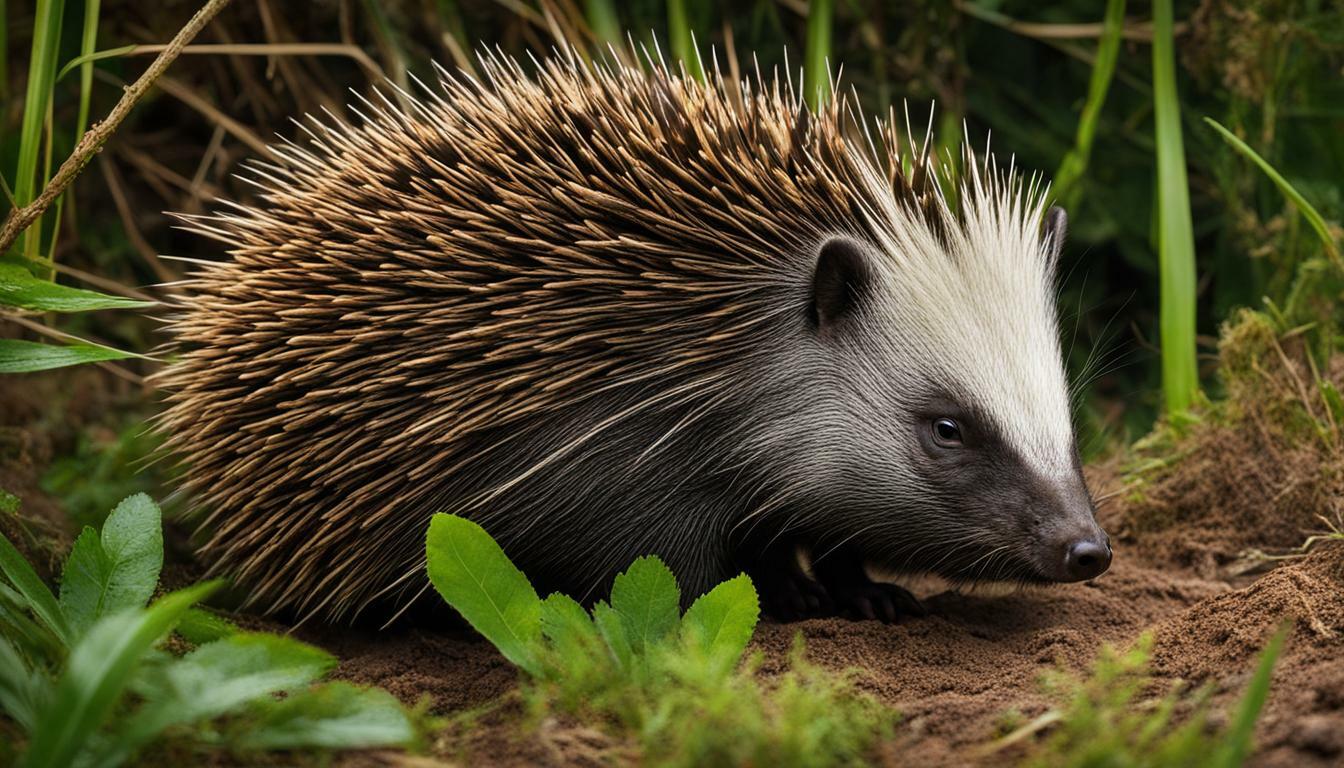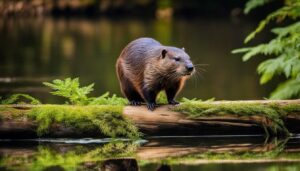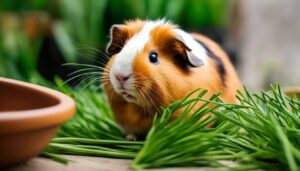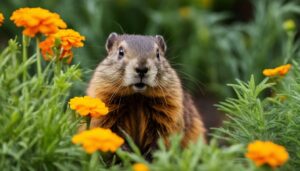The question of whether porcupines lay eggs is a common one among wildlife enthusiasts and curious minds alike. Porcupines, being unique mammals, have a reproductive process that sets them apart from egg-laying creatures.
Female porcupines have a gestation period of around 7 months before giving birth to one or two offspring, called porcupettes. Unlike reptiles or birds, porcupines do not lay eggs. Porcupines are mammals and belong to the rodent family, giving birth to live young.
Porcupettes are born with soft quills that harden within a few hours. These quills serve as a formidable defense mechanism for porcupines, as they raise them when threatened. Porcupines primarily employ this defense mechanism when faced with potential predators in their natural habitat.
Porcupines are primarily nocturnal animals, meaning they are most active during the night. This nocturnal behavior has an impact on their reproductive behavior. By being active at night, porcupines can avoid predators and focus on mating and raising their young. During the night, they forage for food, explore their habitat, and engage in social interactions.
Mating rituals in porcupines involve various courtship behaviors, mate selection, and competition between males. These rituals play a crucial role in the reproduction process of porcupines, ensuring successful breeding and the continuation of their species.
Key Takeaways:
- Porcupines do not lay eggs; they give live birth.
- Female porcupines have a gestation period of around 7 months.
- Porcupettes are the offspring of porcupines.
- Porcupines have quills as a defense mechanism.
- Porcupines are primarily nocturnal animals.
Porcupine Reproduction: Live Birth and Gestation Periods
Unlike some other animals, porcupines do not lay eggs; instead, they give birth to live offspring after a lengthy gestation period. Female porcupines have a gestation period of approximately 7 months before bringing their young into the world. These adorable offspring, known as porcupettes, are born with soft quills that harden within a few hours. It’s fascinating to witness how quickly these quills develop and provide them with the signature protection that porcupines are known for.
Porcupines belong to the rodent family and are mammals. They utilize their quills as a formidable defense mechanism when threatened. When a porcupine feels threatened, it raises its quills to intimidate potential predators and ward off attacks. These quills are sharp and barbed, making them difficult to remove once embedded in the skin of an attacker.
Porcupines are primarily nocturnal creatures, meaning they are most active during the nighttime hours. This nocturnal behavior has a direct impact on their reproductive habits. Being active at night allows porcupines to avoid predators and focus on mating and raising their young. They forage for food, explore their habitat, and engage in social interactions under the cover of darkness, ensuring the survival and continuation of their species.
| Gestation Period | Nocturnal Behavior | Mating Rituals |
|---|---|---|
| Around 7 months | Primarily nocturnal | Courtship behaviors, mate selection, competition between males |
In conclusion, porcupines do not lay eggs; they give birth to live offspring. Female porcupines undergo a gestation period of approximately 7 months before delivering their porcupettes. These little ones are born with soft quills that harden shortly after birth. Porcupines use their quills as a defense mechanism, and their nocturnal behavior allows them to focus on reproduction and avoiding predators. Mating rituals in porcupines involve courtship behaviors and competition between males. Understanding the unique reproductive behavior of these fascinating creatures helps us appreciate the wonders of the animal kingdom.
Porcupettes: The Offspring of Porcupines
When female porcupines give birth, the young are called porcupettes, and they are born with soft quills that harden within hours. These adorable creatures are the offspring of porcupines and inherit their parents’ unique quill-covered appearance. However, the quills of porcupettes are initially soft and pliable, providing them flexibility and safety during the early stages of their lives.
The development of porcupettes is truly fascinating. Within a few hours of being born, their quills start to harden, transforming into the sharp, needle-like spines that are synonymous with porcupines. As they grow, porcupettes begin to explore their surroundings and learn from their parents, gradually adapting to life in their natural habitat.
Porcupettes rely on their quills for protection from potential threats. When they sense danger, they raise their quills to create an imposing and formidable defense mechanism. This is essential for their survival, as porcupines are often preyed upon by predators such as wolves, coyotes, and other large mammals.
| Porcupette Facts | |
|---|---|
| Growth Rate | Porcupettes grow rapidly during their first year of life, reaching adult size within 10-12 months. |
| Social Behavior | Porcupettes stay close to their mother for the first few months, learning important survival skills and socializing with other porcupines. |
| Fur and Coloration | Porcupettes are born with a soft, light-colored fur that gradually darkens as they mature. |
As porcupettes grow, they become more independent and eventually separate from their mothers to establish their own territories. However, they may still join other porcupines in social interactions and mating rituals, continuing the cycle of porcupine reproduction.
Porcupettes are a fascinating example of the incredible diversity found in the animal kingdom. Their unique quills and development process exemplify the remarkable adaptations and strategies that enable animals to thrive in their environments. As we delve deeper into the world of porcupines, we discover a wealth of intriguing information about these captivating creatures and their offspring.
Porcupine Quills: A Formidable Defense Mechanism
Porcupines use their sharp, barbed quills as a formidable defense mechanism, raising them when threatened to deter predators. These quills are their primary line of defense, serving as an effective deterrent against potential threats. When a porcupine feels threatened, it will raise its quills, making itself appear larger and more dangerous to potential predators.
The quills themselves are unique and specialized structures designed to protect the porcupine. They are made of keratin, the same substance found in human hair and nails, but with a modified structure. Each quill has a sharp, needle-like tip and tiny backward-facing barbs along its length, making it difficult for predators to remove once embedded in their skin. This defense mechanism is highly effective against most predators, including larger carnivores such as wolves and mountain lions.
Porcupine Quill Facts
- Porcupines have an average of 30,000 quills covering their bodies.
- Quills on the head and back are longer and more rigid, while those on the sides and tail are shorter and more flexible.
- Contrary to popular belief, porcupines cannot shoot or throw their quills. They can only release them upon contact or when they make direct contact with a predator.
It’s important to note that porcupines do not attack or aggressively use their quills. They prefer to rely on their impressive appearance and warning signals before resorting to quill deployment. If a predator ignores these warnings and continues to approach, the porcupine may lunge backward into them or swat their tail, effectively embedding the quills in their attacker’s skin.
| Quill Characteristics | Function |
|---|---|
| Sharp Tip and Barbs | Makes it difficult for predators to remove quills once embedded. |
| Keratin Composition | Provides strength and durability to withstand predator attacks. |
| Variable Length and Flexibility | Allows for effective coverage and protection on different parts of the body. |
Despite the formidable nature of their quills, porcupines are generally peaceful animals that prefer to avoid conflict whenever possible. Their quills serve as a means of defense, allowing them to protect themselves and their offspring from potential danger. Understanding the unique characteristics and function of porcupine quills provides valuable insight into the fascinating world of these intriguing creatures.
Nocturnal Behavior: Impact on Porcupine Reproduction
Porcupines are primarily nocturnal animals, which allows them to avoid predators and focus on mating and raising their young. Their nighttime activity patterns are a critical aspect of their reproductive behavior and overall survival. Being active at night helps porcupines minimize the risk of encountering predators that are more active during the day. By foraging and exploring their habitat under the cover of darkness, they can find food more easily and conserve energy.
Nocturnal behavior also plays a significant role in porcupine reproduction. During the night, male porcupines actively seek out females to mate with. They use scent marking and vocalizations to attract potential mates and establish their territories. Competition between males can be fierce, as they vie for the opportunity to reproduce. This competition often involves aggressive encounters, where they may fight and engage in physical combat to establish dominance and secure mating rights.
For female porcupines, being nocturnal allows them to select the most suitable mate while avoiding unwanted advances from males. It also enables them to focus on raising their young without the added stress of daytime predator threats. Female porcupines have a gestation period of around seven months before giving birth to one or two porcupettes. These offspring are born with soft quills that harden within a few hours, providing them with immediate protection.
In summary, the nocturnal behavior of porcupines is vital for their reproductive success. It allows them to avoid predators, engage in mate selection, and ensure the survival of their offspring. By being active at night, porcupines can effectively carry out their reproductive behaviors and secure the future of their species.
Mating Rituals in Porcupines: Courtship and Competition
Mating rituals in porcupines involve intricate courtship behaviors, mate selection, and competition between males for reproductive success. These rituals play a crucial role in ensuring successful reproduction and passing on genetic traits.
Male porcupines engage in a variety of courtship behaviors to attract female mates. These behaviors can include vocalizations, such as grunts or squeaks, as well as physical displays, such as raising their quills or tail fluffing. Courtship rituals also involve scent marking, where males release pheromones to signal their availability and dominance.
Competition between males for female mates is fierce, with dominant males often monopolizing breeding opportunities. They will engage in aggressive displays, such as wrestling or pushing each other, to establish dominance and secure their chances of reproducing. In some cases, males may even engage in physical fights, using their sharp quills as weapons, to gain an advantage in the competition.
Once a male successfully mates with a female, she will undergo a gestation period of around 7 months before giving birth to one or two porcupettes. These offspring are born with soft quills that harden within a few hours, providing them with early protection. The female porcupine plays the primary role in raising the porcupettes, providing them with nourishment and protection until they are able to venture out on their own.
| Key Points: |
|---|
| Mating rituals in porcupines involve intricate courtship behaviors, mate selection, and competition between males for reproductive success. |
| Male porcupines engage in vocalizations, physical displays, and scent marking to attract female mates. |
| Competition between males for female mates can be intense, with dominant males often securing breeding opportunities. |
| Female porcupines have a gestation period of around 7 months before giving birth to one or two porcupettes. |
| Porcupettes are born with soft quills that harden within a few hours, providing them with early protection. |
Facts About Porcupines: Behavior and Habitat
Apart from their reproductive behavior, porcupines exhibit fascinating behaviors and are adapted to thrive in various habitats. Known for their distinctive quills, porcupines are primarily nocturnal animals that are most active during the night. This behavior enables them to avoid predators and focus on essential activities such as foraging for food, exploring their surroundings, and engaging in social interactions.
Porcupines belong to the rodent family and are native to several regions around the world, including North and South America, Europe, and Asia. They are highly adaptable creatures and can be found in a variety of environments, ranging from forests and woodlands to grasslands and deserts.
Porcupine Behavior
When threatened, porcupines rely on their unique defense mechanism—their quills. These sharp, barbed spines cover their bodies and are raised when the porcupine feels in danger, creating a formidable deterrent for potential predators. Contrary to popular belief, porcupines do not shoot their quills; instead, they use their muscular bodies to embed the quills into their attackers, which can cause pain and discomfort.
Porcupettes, the offspring of porcupines, are born with soft quills that harden within a few hours. This adaptation allows them to be protected from birth and learn how to use their quills effectively as they grow. Porcupines are generally solitary animals, but they may form small social groups, especially during mating season.
| Porcupine Facts | |
|---|---|
| Scientific Name: | Erethizon dorsatum |
| Body Length: | 60 – 90 cm |
| Weight: | 5 – 16 kg |
| Habitat: | Forests, woodlands, grasslands, deserts |
| Lifespan: | Up to 18 years |
| Diet: | Herbivorous – feeds on plants, bark, and leaves |
Interesting Wildlife Facts: Porcupines and Egg Laying
While porcupines are intriguing creatures, it is important to clarify that they do not lay eggs, contrary to popular belief. Porcupines are mammals, belonging to the rodent family, and like other mammals, they give live birth to their young. Female porcupines have a gestation period of approximately 7 months before giving birth to one or two offspring known as porcupettes.
Porcupettes are born with soft quills that harden within a few hours. These quills serve as a formidable defense mechanism for porcupines. When threatened, they can raise their quills, making themselves appear larger and deterring potential predators.
Porcupines are primarily nocturnal animals, meaning they are most active during the night. This nocturnal behavior has a significant impact on their reproductive patterns. Being active at night allows porcupines to avoid predators and focus on mating and raising their young. During the night, they forage for food, explore their habitat, and engage in social interactions.
The mating rituals of porcupines involve courtship behaviors, mate selection, and competition between males. Males will often engage in battles, where they try to establish dominance and win the right to mate with females. Once a female has selected a suitable mate, they engage in courtship behaviors, further solidifying their bond.
| PORCUPINE FACTS |
|---|
| Porcupines do not lay eggs |
| They give live birth to one or two offspring called porcupettes |
| Porcupettes are born with soft quills that harden within hours |
| Porcupines use their quills as a defense mechanism |
| They are primarily nocturnal animals |
| Nocturnal behavior allows them to focus on mating and raising their young |
| Mating rituals involve courtship behaviors and competition between males |
Exploring Porcupine Eggs: A Common Misconception
The idea of porcupine eggs is a common misconception, as it contradicts the known reproductive behavior of these mammals. Porcupines do not lay eggs; they give live birth to their offspring, just like other mammals. Female porcupines have a gestation period of around 7 months before bringing their porcupettes into the world.
Porcupettes, the offspring of porcupines, are born with soft quills that harden within a few hours. These quills play a crucial role in the porcupine’s defense mechanism. When threatened, porcupines can raise their quills, making themselves appear larger and deterring potential predators. This unique adaptation helps porcupines to protect themselves and their young.
Porcupines are primarily nocturnal animals, meaning they are most active at night. This nocturnal behavior has an impact on their reproduction. Being active during the night allows porcupines to avoid predators and focus on mating and raising their young. During this time, they forage for food, explore their habitat, and engage in social interactions.
Mating rituals in porcupines involve courtship behaviors, mate selection, and competition between males. Male porcupines actively compete for the opportunity to mate with females, showcasing their dominance through various displays and vocalizations. This competition ensures that the strongest and most genetically suitable males have the chance to pass on their genes to the next generation.
| Porcupine Reproduction Facts |
|---|
| Porcupines give live birth, they do not lay eggs. |
| Female porcupines have a gestation period of approximately 7 months. |
| Porcupettes are born with soft quills that harden within hours. |
| Porcupines use their quills as a defense mechanism when threatened. |
| Porcupines are primarily nocturnal animals, most active at night. |
| Mating rituals in porcupines involve courtship behaviors and competition between males. |
Conclusion
In conclusion, porcupines do not lay eggs but give birth to live offspring after a gestation period, showcasing fascinating reproductive behaviors of these remarkable mammals. Female porcupines have a gestation period of around 7 months before giving birth to one or two offspring, known as porcupettes. These adorable young porcupines are born with soft quills that quickly harden within a few hours, providing them with the means to protect themselves.
Porcupines utilize their quills as a formidable defense mechanism by raising them when threatened. This unique adaptation helps ward off potential predators and ensures their survival in their natural habitat. Additionally, porcupines are primarily nocturnal animals, meaning they are most active at night. Their nocturnal behavior allows them to avoid predators and focus on mating and raising their young.
Mating rituals in porcupines involve fascinating courtship behaviors, mate selection, and competition among males. These rituals play a crucial role in the continuation of the species and are a testament to the complexity of nature’s reproductive processes. As mammals belonging to the rodent family, porcupines exhibit remarkable capabilities in their reproductive behaviors.
Please note that the HTML tags
,
, , and
are not displayed above, but they should be included in the actual HTML code.
FAQ
Do porcupines lay eggs?
No, porcupines do not lay eggs. They give live birth to one or two offspring, called porcupettes.
What is the gestation period for female porcupines?
The gestation period for female porcupines is around 7 months.
What are the offspring of porcupines called?
The offspring of porcupines are called porcupettes.
Are porcupettes born with hard quills?
No, porcupettes are born with soft quills that harden within a few hours.
How do porcupines use their quills?
Porcupines use their quills as a defense mechanism, raising them when threatened.
Are porcupines nocturnal animals?
Yes, porcupines are primarily nocturnal animals and are most active at night.
What do porcupines do during the night?
During the night, porcupines forage for food, explore their habitat, and engage in social interactions.
How does nocturnal behavior impact porcupine reproduction?
Nocturnal behavior allows porcupines to avoid predators and focus on mating and raising their young.
What are the mating rituals in porcupines?
Mating rituals in porcupines involve courtship behaviors, mate selection, and competition between males.




